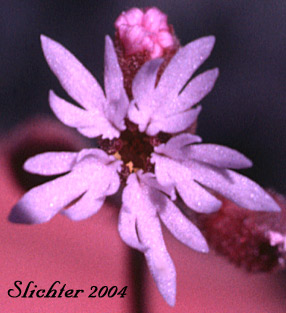

Smooth Fringecup, Smooth Prairie Star, Bulblet Prairie Star, Bulbous Woodland-star, Bulbiferous Prairie-star: Lithophragma glabrum (Synonyms: Lithophragma bulbifera, Lithophragma glabra) - Stems reddish. Flowers white or pink with cleft petals. Calyx cup-shaped. Reddish-purple bulblets commonly found on this species. Basal leaves glabrous or lightly hairy, often 3 lobed and divided nearly to the base.
Smooth Fringecup, Smooth Prairie Star, Bulblet Prairie Star, Bulbous Woodland-star, Bulbiferous Prairie-star: Lithophragma glabrum (Synonyms: Lithophragma bulbifera, Lithophragma glabra) - Stems reddish, somewhat hairy and glandular. Flowers usually pink, the five petals cleft or divided into thin, tattered lobes. Calyx cup-shaped. Flowers 5-15 at the top of the stem. Bulblets may be found instead of flowers. Basal leavesglabrous or lightly hairy, often 3-lobed and divided nearly to the base.
Small-flowered Fringecup, Small-flowered Prairiestar, Small-flowered Prairie-star, Small-flowered Prairie Star, Small-flowered Woodland-star: Lithophragma parviflorum var. parviflorum (Synonym: Lithophragma parviflora) - No bulblets present. Basal leaves deeply divided 3-5 times, but not to the base. Stem leaves compound but 3-foliate. The 5 petals white or pinkish, each with 3 lobes at the tips. Calyx long and thin, widest at the mouth and tapering gradually to the stem, about twice as long as wide. Ovaries greater than 1/2 inferior.
Slender Woodland Star: Lithophragma tenellum (Synonyms: Lithophragma rupicola, Lithophragma tenella) - No bulblets present. Basal leaves light green, deeply divided, but not to the base. Stem leaves 3-lobed, appearing pinnatifid. Calyx rounded at the base. Petals are 3-lobed at the tip with 1-2 pairs of smaller lobes from the base. Ovaries to 1/2 inferior.